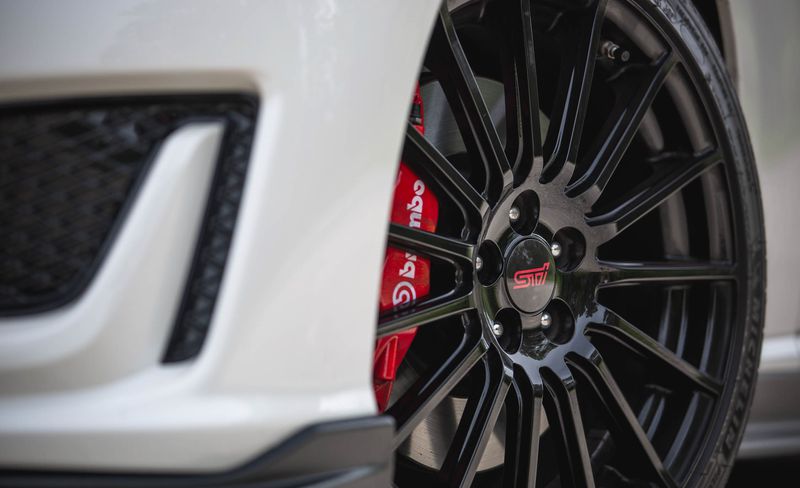Limited to a production run of just 500 for 2018, the Subaru BRZ tS (“tuned by STI”) is the new benchmark version of the company’s rear-wheel-drive sports coupe. This dialed-in BRZ offers more grip and control than ever before while retaining the brilliant car’s familiar well-balanced character. That said, if you’re someone who has always thought the BRZ needs another 100 horsepower, you’ll come away from the tS experience with that belief still intact.
Subaru and STI engineers described their goal in tuning the BRZ tS as “pure handling delight,” a mission easily stated but difficult to achieve in a car already well known for its precision and balance. To reach its goal, Subaru extensively tweaked the chassis. The Sachs dampers of the BRZ Limited’s available Performance package have been tuned to work with 18-inch STI wheels and—finally—stickier rubber, with the tS wearing Michelin Pilot Sport 4 tires, size 215/40R-18.
The BRZ tS does a good job of looking like a manufacturer-tuned special edition. The fog lights in the front bumper are deleted in favor of more aggressive-looking faux intakes, and an STI front splitter visually lowers the nose. It looks good enough that we’re willing to overlook the Cherry Blossom Red accent around the grille. There’s another red stripe across the rear bumper and still more red accents inside, including on the seat bolsters, door panels, and seatbelts.
The sides of the car are accentuated with STI skirts and mirrors done in black. The most noticeable change is the carbon-fiber wing. Despite its ground-hugging looks, it doesn’t result in net downforce. Instead, it reduces the lift on the rear axle at speed. It’s adjustable, too, although even in the steeper position no downforce is made.
The visual amendments, when viewed in person, make the car look lower, while the larger wheel-and-tire package helps lend the tS a squat, purposeful demeanor.
More Grip for a Great Chassis
All of the chassis upgrades combine to make everything that was good about the BRZ even better, including well-judged steering with about as much feedback as you could hope for. In the BRZ tS, that great rack is even sharper thanks to the improved rubber and the chassis stiffening; the front crossmember specifically is said to reduce the delay between input and chassis response (we noticed no delay at all).
Those Michelin Pilot Sport 4 tires replace the comically weak Michelin Primacy HP rubber found on even the Performance-package BRZ, and the difference in grip is astounding. During our annual Lightning Lap event, the tS shaved 4.6 seconds off the 2013 BRZ’s lap time. The increased traction allows the coupe to be driven into and out of corners with more aggression. Throttle-induced oversteer is now largely absent, and the BRZ’s chassis balance is superb; carefully executed trail braking allows the driver to steer the tS with the middle pedal. On the skidpad, the BRZ tS sticks to the tarmac with 0.98 g of lateral force, a substantial increase over the standard car’s 0.90 g. The ability to adjust the BRZ’s line remains unchanged—it just happens at higher cornering speeds.
The Brembo brakes from the Performance package also make their way over to the loaded BRZ tS, with 12.8-inch discs up front and 12.4-inchers at the rear. They’re paired with STI springs that are 15 percent stiffer in the front and 3 percent stiffer out back. There’s a flexible strut-tower brace and a flexible lower-front-crossmember brace as well, both of which use ball joints (hence the “flexible” appellation) to limit noise, vibration, and harshness. The big brakes paired with the gummy Michelins deliver untiring performance throughout repeated abuse, and the pedal never threatens to go soft. The tS came to a halt from 70 mph in just 151 feet, 13 feet shorter than the regular BRZ.
Same Ol’ Engine
If there’s a problem with the tS, it’s that the engine is unchanged. The coupe’s enhanced grip casts a bright light on the engine’s shortcomings. The 2.0-liter flat-four at the heart of the tS still generates the same 205 horsepower that the standard BRZ has made since the 2017 model year. (That was up five ponies from earlier models, but only on manual-transmission cars; the automatic isn’t an option on the tS.) Its song remains the same when you wind it out, which is something you still have to do given that horsepower peaks at 7000 rpm, and the full 156 lb-ft of torque isn’t present until the engine is spinning at 6400 rpm. The key to reaching 60 mph in 6.3 seconds is avoiding the EKG dip in the torque curve below 5000 rpm. Launch it just above 6000 rpm and be ready with a quick shift. The six-speed gearbox operates with tremendous fidelity. With the shifts just right, the BRZ tS covers the quarter-mile in 14.9 seconds at 94 mph. These times are 0.1 second slower than the previous model’s, but the BRZ tS isn’t about the drag strip; it’s on the racetrack and back roads that this coupe shines.
Even after subjecting the tS to repeated trips on our 10Best evaluation loop and making frequent forays to the car’s 7400 rpm in the process, we still managed to match the EPA’s 23-mpg combined rating. And though the front splitter and rear wing increase the coupe’s aero profile, we recorded an impressive 32 mpg during our 75-mph highway fuel-economy test, handily beating the EPA’s estimate of 27 mpg.
The world is full of turbocharged hot hatches in the BRZ’s price range. But if balance, grip, and turn-in are even a little bit your kind of thing, you’re not going to find anything quite like the BRZ tS. It’s a product worthy of special-edition status. The chassis and steering on the BRZ tS are just that good. The BRZ is a razor-sharp samurai sword that only the skilled may wield to its greatest potential. It’s just hard not to dig it, wheezy engine or not.
Source: Car and Driver | By DAVID BEARD, JAMES TATE | December 26, 2018 | https://www.caranddriver.com/reviews/2018-subaru-brz-ts-first-drive-review


Recent Comments